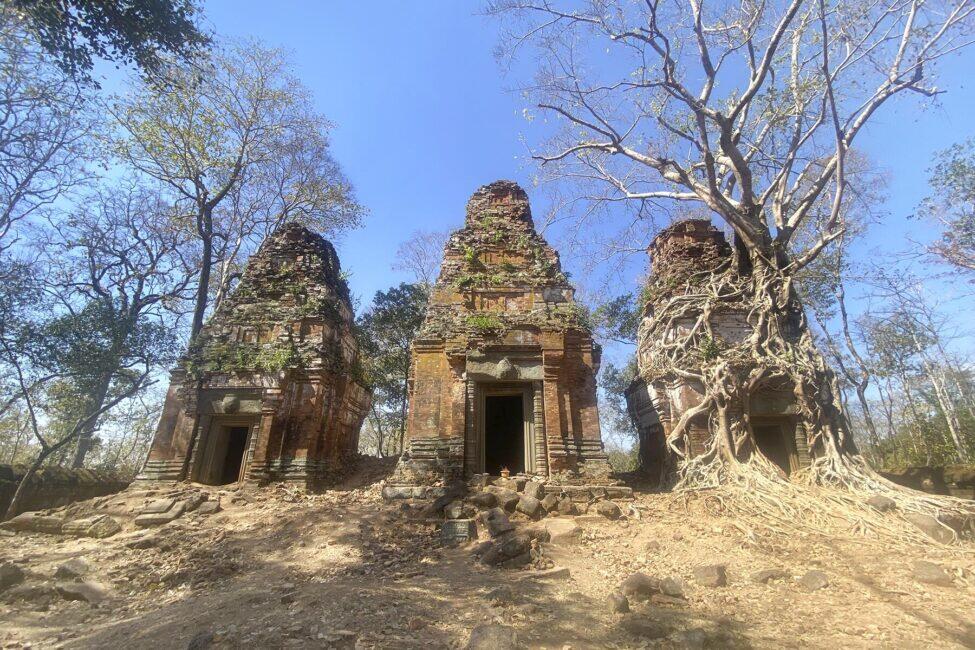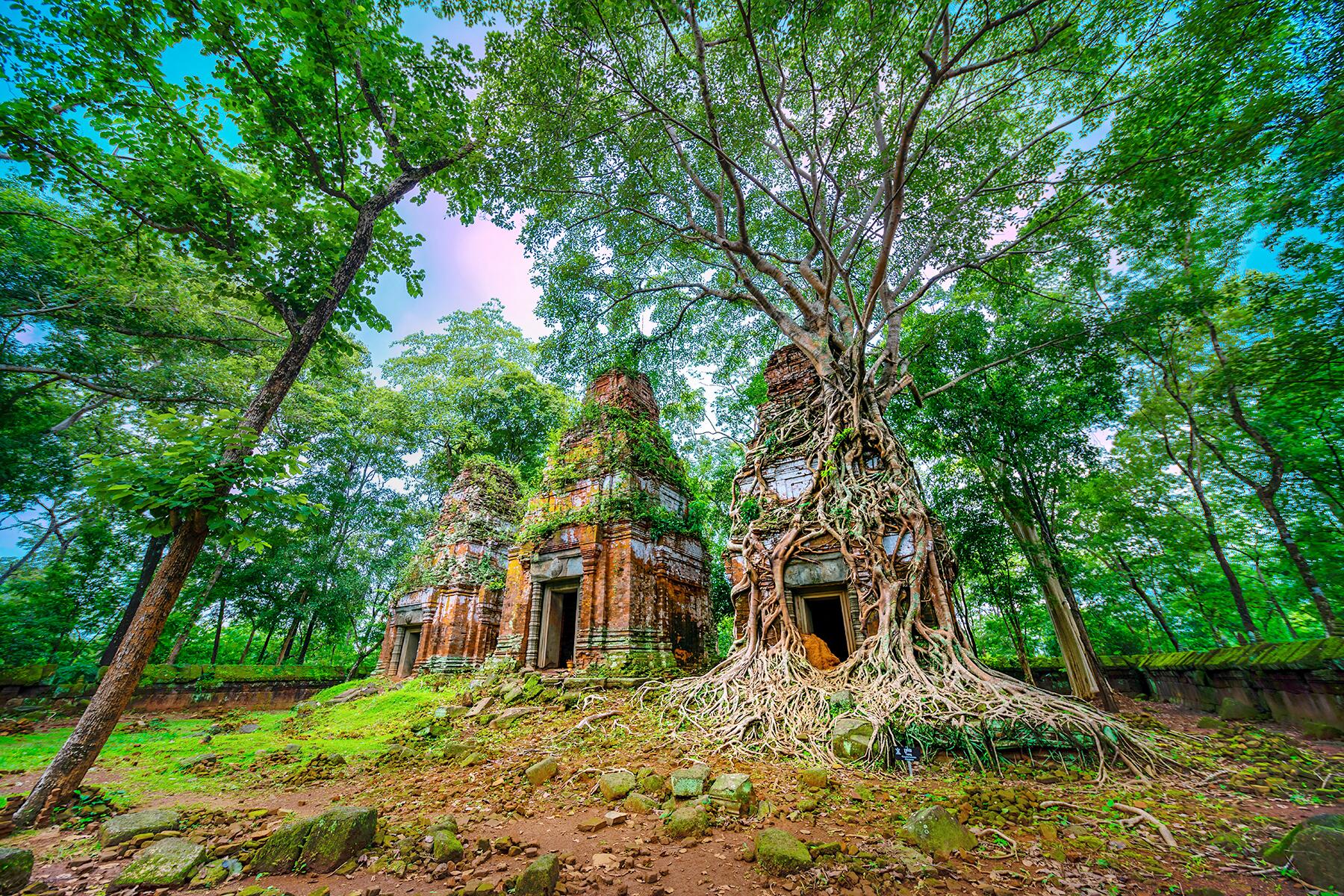Koh Ker, the Cambodian temple complex awarded UNESCO status in 2023, fights for the return of its plundered artifacts.
On a hot, sticky day in Cambodia, I’m standing atop Asia’s only seven-sided temple, a pyramid-like structure surrounded by vast swathes of kapok, fig, and banyan trees. To my right, the humid air occasionally stirs the Cambodian flag attached to the flagpole fixed to the top of the temple. It’s adorned with an image of Angkor Wat–the archaeological site that put this part of Cambodia on the map. But there’s another temple in town: Koh Ker, which refers not only to the structure I’m standing on but a vast complex comprising around 80 nearby temples.
I arrived in Siem Reap 17 years after my first visit to Cambodia’s temple town, when I traveled overland from Bangkok in a taxi with a cracked windscreen and long-gone suspension, struggling to cope with the unpaved road that led to the town. Today, things look rather different. Siem Reap’s roads are freshly paved, and there’s a shiny new airport that opened in 2023. Somewhat depressingly, its center now has a McDonalds, Starbucks, and KFC. Pub Street (yes, that really is its name), the backpacker hangout where tourists gather to drink cheap towers of Angkor Beer, remains unchanged, its moniker picked out in what appears to be the same bright red neon letters that drew me here almost two decades ago.
Recommended Fodor’s Video
For the vast majority of these people, Angkor Wat, the enormous temple complex and former Khmer capital, is still the site with the most pulling power. But there’s a new (or, in reality, very old) crowd-puller for visitors to Cambodia: Koh Ker, which was the second most important Khmer kingdom after Angkor Wat. And, it turns out, one which looks totally different. Koh Ker, a two-hour drive from Siem Reap, was the capital of the Khmer Empire from 928 AD to 944 C.E. It was built by King Jayavarman IV after a presumed breakdown in the line of succession, which saw him leave Angkor Wat.
This breakaway Khmer capital’s Brahmanic temples and prasats (towers) look very different from the temples of Angkor Wat, and Koh Ker’s pièce de resistance is the huge, seven-tiered Koh Ker temple, which has more in common with Mexico’s Chichén Itzá temple than the structures at Angkor Wat.

At crowd-free Koh Ker, the sense of remoteness is immediate. I spot several signs listing details about recent mine-clearing operations; many carried out by APOPO, a charity that trains African rats (supersized rodents with kangaroo-style pouches) to sniff out these lethal reminders of Cambodia’s brutal civil war. In some areas, these signs reveal that the last mines were cleared as recently as 2010.
Koh Ker is a site that has remained largely hidden from the rest of the world, and there’s a sense that certain temples are on the verge of being reclaimed by the jungle surrounding its most important structures. Take Prasat Pram, barely visible beneath a banyan tree’s tendril-like roots, which twist down its crumbling walls before disappearing into the earth. I’m almost certain the temple would collapse were these roots ever removed.
At Koh Ker, which is the name of a towering, seven-tiered temple as well as the entire site, restoration work has already begun in anticipation of the inevitable increase in visitor numbers. There are hastily erected signs that drones are banned, and a new staircase is being constructed for visitors keen to reach its summit. Which, I should point out, is very much needed. Currently, the only way to reach the top of Koh Ker is by clambering up a wobbly staircase clinging to the side of the lichen-covered stonework. At the top, my guide points to the location of the original staircase he climbed during a previous visit–a structure which was, he says, so unstable that he almost turned back at the halfway point.
It’s not just Asia’s only seven-sided temple that makes Koh Ker unique. Something else sets it apart–the huge piles of bricks I spot inside the crumbling ruins of its structures. At Angkor Wat, these were cleared away years ago by local authorities keen to erase the reminders of the time when looters plundered Cambodia’s first Khmer Kingdom. Koh Ker wasn’t so lucky. Looters continued to plunder its temples until recent years, reminders of which are the signs pleading with visitors to respect the country’s newest UNESCO-listed archaeological site.
Other reminders of this looting are everywhere. At Prasat Khnar, four stone elephants once stood guard at each corner of the temple. Today, only one remains in place. Two are missing, and the remains of another have been placed on the ground, the ornately carved elephant’s body haphazardly propped up by the amputated sections of the trunk and legs.

Much of this looting was carried out by locals who are offered huge sums for stolen artifacts, and experts believe a British man, Douglas Latchford, masterminded the majority of these thefts. Latchford was living in Southeast Asia when he realized that private collectors, museums, and galleries around the world were willing to pay huge sums for relics taken from temples such as Koh Ker. For years, Latchford drove up and down the road between Siem Reap and Koh Ker, offering locals huge sums of cash to anyone who could provide artifacts taken from the site. He’d then sell them on to museums and private collectors, amassing a huge fortune in the process.
Institutions that purchased Latchford’s pilfered artifacts include New York’s Metropolitan Museum of Art (various Cambodian art experts believe it still has dozens in its possession) and the British Museum. In recent years, an American lawyer and amateur archaeologist, Bradley Gordon, has made it his mission to return these items to Cambodia. Gordon now acts as an advisor to the Cambodian Ministry of Culture and Fine Arts and has been awarded Cambodian citizenship in recognition of his work, which has seen numerous artifacts returned to the country.
He describes these museums and institutions as “laundromats” for Koh Ker’s treasures, many of which were taken by locals tempted by the huge sums offered by people such as Latchford. But there’s hope on the horizon. Latchford died in 2020, and in 2021, his daughter agreed to return 125 statues and gold relics looted from Cambodia. She recently handed over $12 million from his estate to the Cambodian government.
Almost all of the guards at Koh Ker come from local villages, and their presence–and more specifically, their new-found pride in this newly certified UNESCO site–is crucial to its protection. “There are villages close to the temples of Koh Ker, and this is where a lot of the looters came from, says Gordon. “Many of the guards you’ll see at the site are descendants of people who were involved in the looting.”
Around the world, there are numerous examples of situations where locals’ shifting attitudes have been key to the protection of archaeological sites, endangered species, and ancient artifacts. In Cambodia, there’s the sense that a growing number of locals now feel pride in their heritage sites. The guards whose ancestors profited from the unscrupulous actions of people like Douglas Latchford are now protecting the temples that they plundered, and I suspect the future of Cambodia’s newest UNESCO site is in safe hands. And who knows? Perhaps one day, the flag planted atop its seven-sided temple will feature Koh Ker instead.



